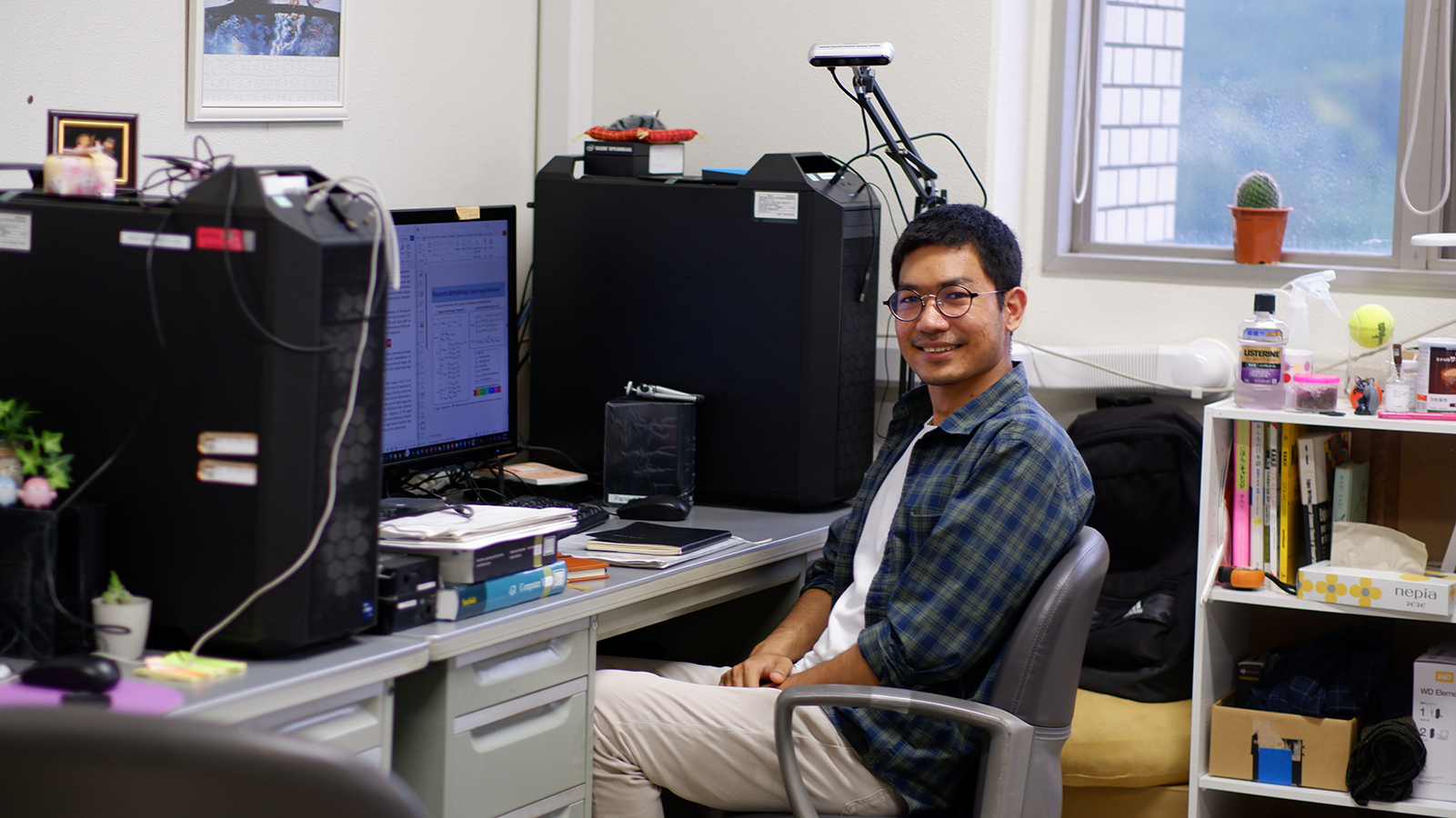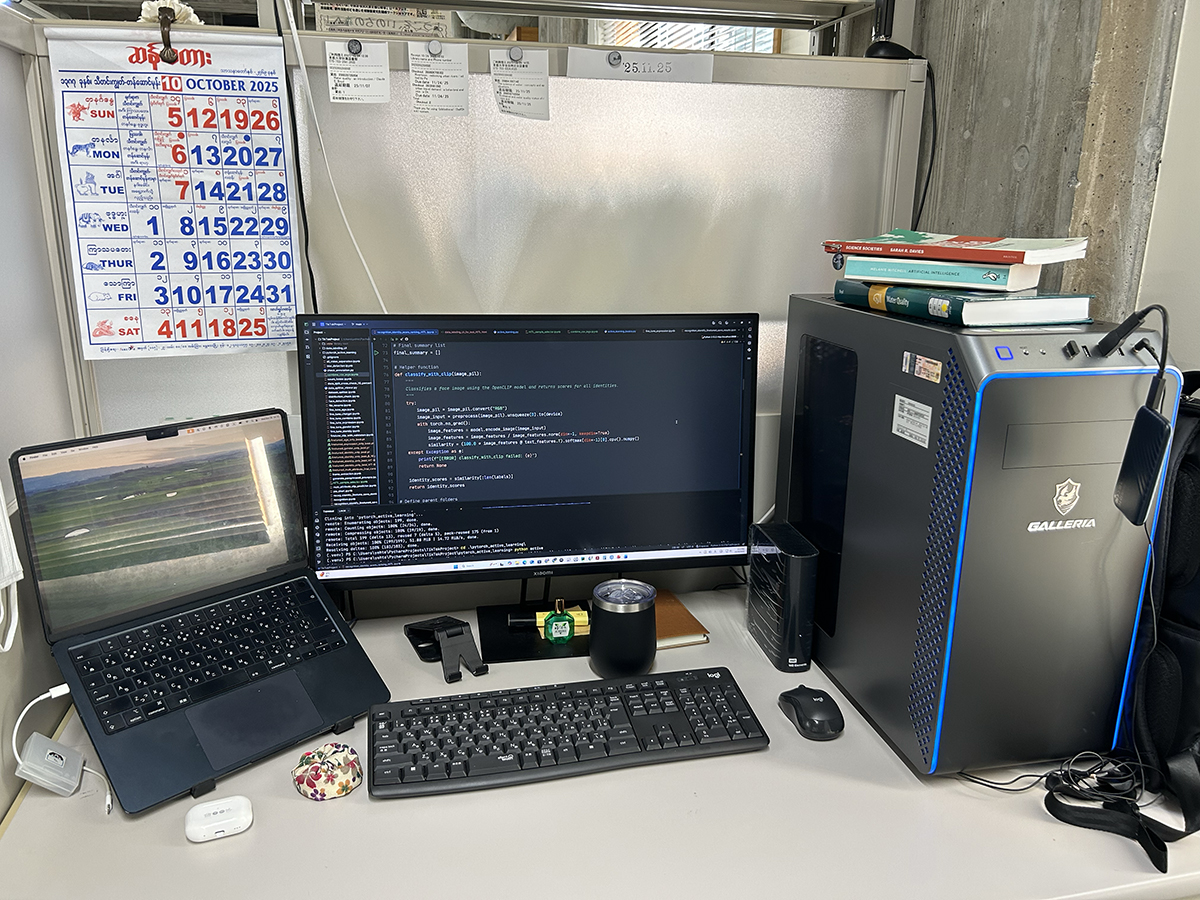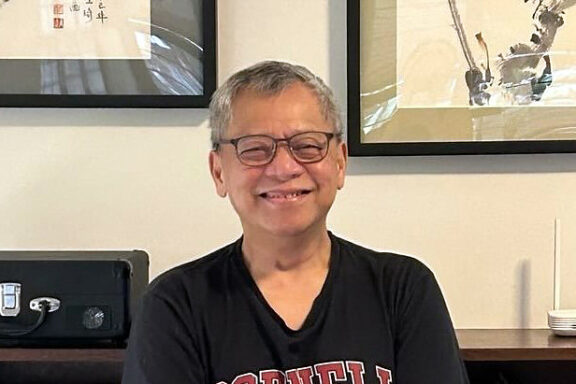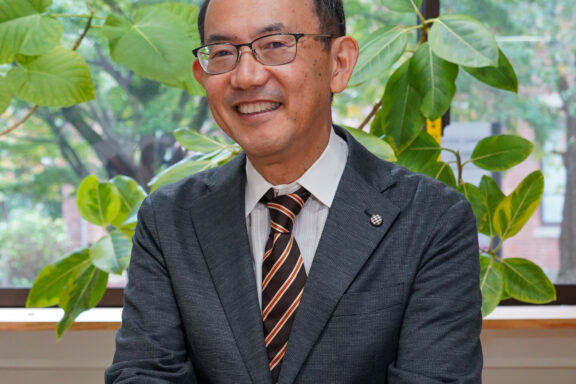Interview with Ye Htet

Short Bio
My name is Ye Htet, a Burmese, and I am originally from Burma (Myanmar). I am currently a postdoctoral Research Associate at the Center for Southeast Asian Studies (CSEAS), Kyoto University. Before joining CSEAS in Kyoto, I lived in Miyazaki on Japan’s Kyushu island, where I completed my doctoral degree in Materials and Informatics at the Interdisciplinary Graduate School of Agriculture and Engineering, University of Miyazaki. My academic journey began with a background in Electronic Engineering in my country. Over time, my interests have evolved toward applying informatics to address real-world issues through interdisciplinary approaches. At CSEAS, I am particularly motivated to integrate my technical knowledge with area studies to better understand and contribute to addressing regional challenges.
How can information scientists contribute to community resilience after large-scale disasters like earthquakes, to counter the rapid deterioration of natural environments such as river pollution, and to approaches to entertainment-oriented politics? We asked Dr. Ye Htet—who explores potential for contemporary transdisciplinary research in Burma (Myanmar), Japan, and beyond—about his motivation to become a researcher, future goals, recommended books, and more.
──Please tell us about your research. For each of your research themes, how did you come to work on each theme, and how does each theme relate to the other?
My research focuses on using computers to “see” and “understand” visual information such as photos, videos, graphics, and satellite images. This field is called machine learning-based visual analysis or computer vision, a part of Artificial Intelligence (AI). In simple terms, it means teaching machines to find patterns in images and make decisions on their own. I first learned this skill set during my master’s and doctoral studies, and I have applied it in different areas—such as improving strawberry irrigation in Burma (Myanmar), supporting elderly healthcare, and helping with livestock farming in Japan.
At present, as a researcher at CSEAS, I work with scholars and students from many different backgrounds. Together, we study regional problems in Southeast Asia through three interdisciplinary projects. Two of these projects are inspired by my personal motivation to support my home country, and the third grew from my curiosity about new ideas in Southeast Asian politics.
The first project focuses on assessing the damage caused by the major earthquake that struck central Burma (Myanmar) just four days before I started my position at CSEAS. The disaster affected millions of people, caused thousands of injuries and deaths, and left many missing. Witnessing this tragedy, I felt strongly motivated to contribute to community recovery and resilience. Together with graduate students and local partners, we began developing a way to assess earthquake damage using satellite images and community mapping. Our goal is to support recovery planning and help communities learn lessons that can reduce risks from future disasters.
The second project focuses on river health. We are exploring approaches to study water quality of a river which flows along the border between Thailand and Burma (Myanmar). This river is affected by rapid urban growth and pollution. By developing new ways to monitor and understand water conditions, we hope to provide useful information for both communities and policymakers to protect this river.
The third project explores how people use social media during elections. We are building a machine learning model to analyze videos on platforms like TikTok, focusing on “politainment,” which is a mix of politics and entertainment. In Indonesia’s 2024 general election, this kind of content spread quickly and shaped public opinion in new ways.
Through these projects, I have learned how combining informatics with area studies can help us better understand complex problems. By bringing together technology and social knowledge, we can support smarter and more informed decisions for communities in Southeast Asia.
──What inspired you to become a researcher? What were your influences in graduate school?
My interest in research began during my master’s studies, when I had the chance to work on a real research project for the first time. I enjoyed exploring a topic in depth and sharing ideas with other scholars at workshops and seminars. Those experiences made me want to keep learning and doing research.
During graduate school, I was not a top student in regular coursework—I was just an ordinary student—but I was passionate about research. I especially enjoyed working with local communities, listening to their challenges, and thinking about how research could help fill the gap. That is one of the reasons I decided to study abroad in Japan, a country well known for its strong achievements in research and development.
I believe this curious mindset, combined with my interest in solving real-world problems, is what inspired me to become a researcher.
──How do you overcome the difficulties in putting together the results of your research into a research paper or book?
That is one of the major challenges in my research field. For example, the application of AI is growing rapidly, and new models or methods are published almost every day. As a result, even when I am working on my own technical research, it can be difficult to keep up with the latest developments.
When writing research papers, reviewers often expect the use of the newest models or the most up-to-date information. To address this, I make an effort to continuously learn about emerging technologies and approaches. I regularly read recent papers, follow updates in the field, and carefully reflect on how to integrate new ideas into my work. This helps me stay up-to-date and ensures my research remains relevant and meaningful.
──What are the joys and hardships of research for you?
One of the greatest joys of research for me is the freedom to explore my own ideas and interests. Unlike some of the company projects, where the goals are usually fixed, academic research allows me to ask my own questions, design my own methods, and discover new things at my own pace. This sense of intellectual freedom is very rewarding.
At the same time, one of the biggest challenges is managing time. My research study requires a lot of focused work—reading, writing, coding, and developing algorithms—while also balancing personal and family time. Sometimes it can be difficult to find the right balance between work and personal life. Learning how to manage that balance is an ongoing process for me.
──Please tell us about your must-have gears, or must-haves of research and writing.
As a researcher working with desktop workstations and images, I spend most of my time at my desks – they have become almost like companions in my research life. The tools and objects on these desks are my must-have gears.
When I look back at my Ph.D. days, I still remember the desk where I spent countless hours coding, analyzing images, setting up cameras, and writing draft after draft. It was a modest setup, but it had everything I needed: a high-performance desktop computer, a few essential books, a camera for testing and a notebook for ideas. That small desk became the starting point of my journey to becoming an experienced computer vision researcher.


Now, at my current desk in CSEAS, the tools have not changed drastically, but they have grown alongside my research and experience. My must-haves today include a powerful desktop for deep learning and image processing, an external hard drive for storing large datasets, and a laptop for meetings and mobile writing. I also keep medical eye drops for eyestrain and a small Japanese Otedama for light exercise and thinking breaks. A few books on technical and regional studies are always within reach, reminding me that technology should serve to better understand people and places.
Beyond the machines and tools, what I value most is the atmosphere of the desk itself – a space where ideas can quietly grow. Whether it is a cup of coffee, a clean notebook, or simply good lighting, these small comforts help me focus and keep my mind refreshed. From my Ph.D. desk to my current one, the setup has evolved, but the purpose remains the same: to create, reflect, and connect human thinking with computer vision.
──How has your involvement with and guidance of students affected your research?
Research is not something that can be done alone. New ideas often come through conversations and collaboration with others. I value the moments when I work with and guide students in my research. When they ask me questions, it often makes me reflect on my own understanding. If I cannot explain something clearly, it signals that I need to deepen my own knowledge, and that motivates me to improve. I also like to share with students the challenges I faced when I was in their position, hoping that my experiences can help them overcome similar obstacles more easily.
──Do you have any ideal person you have been striving to emulate as a researcher or educator?
Actually, the 1991 Nobel Peace Prize Laureate from Burma (Myanmar), Aung San Suu Kyi, has a long history with Kyoto University, including her time as a visiting researcher at CSEAS from 1985 to 1986. Because of this, I feel proud to be a junior researcher at the same institute where she once worked. I admire her as an ideal figure not only as a researcher and educator but also for her leadership and dedication to the people of Burma (Myanmar).
In addition, I find inspiration from all the professors I have met throughout my academic journey. Each of them has unique strengths, and I try to learn something valuable from everyone. I know that no one is perfect, but I can absorb and apply the good qualities I see in others to my own life and career.
──Do you have any essential reads (books) that you can recommend to younger people?
Here are three types of books that I think are really helpful. One is for our mind and feelings, one is about the future of technology, and one is about how science connects to our everyday lives.
1) For Our Mind: The Book of Joy: Lasting Happiness in a Changing World by Dalai Lama, Desmond Tutu, Douglas Carlton Abrams
This book is a heartfelt conversation between two wise and compassionate world leaders. I often read it whenever I feel stressed or need to remind myself to stay grounded in heart and mind. They explore a profound question: How can we feel happy and joyful when there is so much sadness in the world? Drawing from their own difficult experiences, they offer simple yet powerful advice on how to find joy, not by avoiding problems, but by facing them with kindness and hope.
2) For Understanding AI: The Road to Conscious Machines by Michael Wooldridge or Artificial Intelligence: A Guide for Thinking Humans by Melanie Mitchell
Have you ever wondered what AI really is? These books explain it clearly, without all the confusing jargon. They separate the real facts about AI from what we see in sci-fi movies. They introduce key concepts such as “machine learning” and show how AI is already a part of our daily life, from our phone to the apps we use. This way, we can think for ourselves about the good and bad sides of AI and be part of the conversation about how we should use it.
3) For Understanding Technology, Science and Society: Science Societies: Resources for Life in a Technoscientific World by Sarah R. Davies
This book was recommended by a professor at CSEAS, and though I am still reading it, I can tell it explores the important connection between science and people. It shows that science is not just something that happens in a lab—it is a human activity that affects all of us. It looks at how we, as a society, think about science, how scientists share their discoveries, and how big scientific topics play a role in our communities and our lives.
──Do you have any words of advice to anyone who wants to become a researcher?
Be passionate about the topic you choose—or, better yet, choose a topic you are passionate about. Research is a long journey, so it is also very important to take care of your health and well-being along the way.
──What are your future plans?
Until now, CSEAS has been more than just a workplace for me—it has been an intellectual home. Here, I have grown both as an independent researcher and as a collaborator, learning how to design projects that integrate technical methods with important regional questions. Looking ahead, I want to carry this spirit forward by continuing to conduct research that bridges informatics with the social and environmental challenges facing Southeast Asia. I also hope to contribute to society in both my home country and Japan by applying the knowledge and experiences I have gained.
This article is also available in Japanese. >>
「情報学と地域研究を統合し、地域理解の可能性を探る」
イエテさんインタビュー





